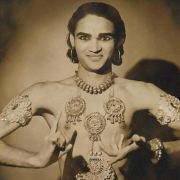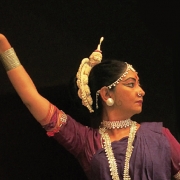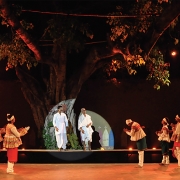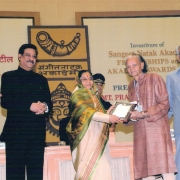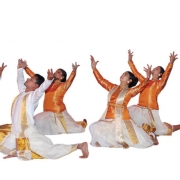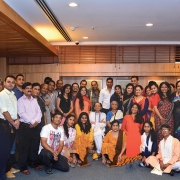
People
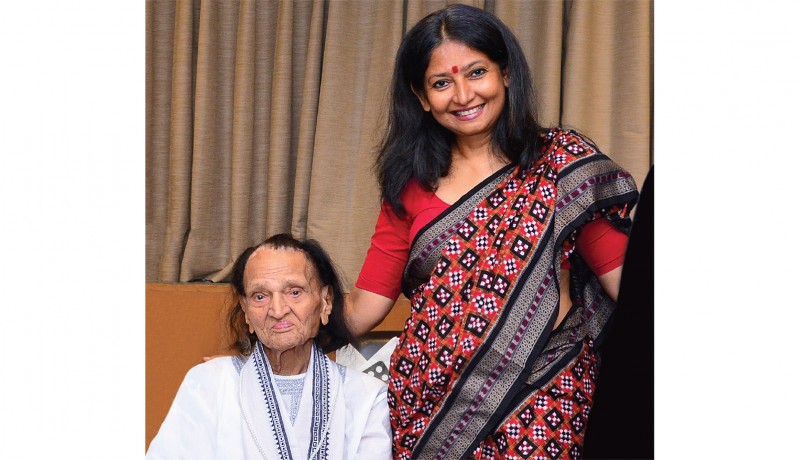
Versatile dancer and choreographer Papiha Desai continues the legacy of her father, dance maestro and choreographer Yog Sunder Desai, reports Rachna Virdi
Back in the 1980s, Delhi was throbbing with art and culture. Mandi House was the cultural hub of the capital and its by-lanes resonated with music, dance and drama. It was in one of these streets that Papiha Desai lived as a child and trained in dance under her veteran dancer-choreographer father Yog Sunder Desai.
The adventurous and distinguished choreographer, 96 today, is ranked among the pioneers of Indian dance and was conferred the Sangeet Natak Akademi Puraskar in 2008. Together, under the banner of the Indian Revival Group (IRG), the father-daughter team has built and presented a remarkable body of work for audiences around the world—and posterity.
IRG was founded by Yog Sunder in 1948 in Calcutta as a dance ensemble dedicated to furthering the rich multicultural heritage, mythology, philosophy and glory of India. Its first programme was a ballet titled Birth of Freedom as India had just attained independence from British rule and the spirit of freedom was in the air.
The group’s vast repertoire includes regular shows, revival projects and new productions. In 1950, IRG presented Rhythms of India for Doordarshan. In 1957, it had the honour of performing for India’s first president Dr Rajendra Prasad and first prime minister Pandit Jawaharlal Nehru as well as other national and international dignitaries at Rashtrapati Bhavan.
Yog Sunder married Geetasree Gupta, an Odissi dancer with IRG, in 1965, and their first child, Papiha, was born the next year in Kolkata. Yog Sunder would frequently travel to Delhi for performances and stay there for months at a stretch. The family finally shifted base to the capital in 1970. Being raised in an atmosphere surrounded by dance and music deeply influenced Papiha, who instinctively imbibed the art form. “My best childhood memories concerning my father and his work revolve around dance and growing up amid artists,” recalls the 52 year-old. “After school, I would spend my time learning dance, watching the rehearsals and shows of the group and other legendary artists at Mandi House.”
Intrigued by the diversity of dance forms in India, Papiha formally trained in Odissi and learnt Kuchipudi and martial art forms under various gurus. At age 15, she joined IRG and delivered her first performance as an adult. “The group was going to Himachal Pradesh for a dance show, Rhythms of India, and I insisted on joining. My father said if I wanted to come, I would have to dance too. It was my debut performance with IRG.”
Being passionate about dance didn’t mean academics were any less important, and Papiha went on to acquire a master’s degree in literature from Delhi University in 1991. But her career in dance was already cut out for her. “My father guided me all along and inspired me to hone my talent as a choreographer and director. In my early 20s, I got the opportunity to choreograph along with him, for Akshardham’s Cultural Festival of India in New Jersey, US, and work independently on projects directed by him.”
Over the years, the father-daughter team has presented performances of great artistic merit across the world. Today, Papiha, who has been at the helm of IRG for the past 20 years, presents her work globally and conducts lecture-demonstrations and workshops at prominent dance schools in India. In an email interview, the dancer speaks about her work, and her father and mentor.
IN HER WORDS
My father’s maternal grandfather Jhaverbhai Amin was Diwan of the state of Limbdi in Gujarat. My paternal grandparents were freedom fighters: Darbar Gopaldas Desai (the Inamdar of Baroda and ruler of Dhasa state in Gujarat) and Bhaktiba Desai. Even though he belonged to a royal family, my grandfather would play dandiya raas, the most popular dance of Gujarat, with his praja, or subjects. That was probably one reason my father fell in love with dance choreography.
My father was born in 1921 in Limbdi and grew up in havelis where singing and dancing were part of Vaishnav culture. Fascinated by the performing arts from childhood, he went on to study in Tagore’s Santiniketan, like his elder brothers, in 1939. There, he learnt painting in Kala Bhawan and then dance at Sangeet Bhawan. Santiniketan kindled his passion for dance. In 1941, he went to Kerala Kalamandalam and trained in Kathakali, Krishnaattam and Mohiniattam under various gurus. His guru, the legendary Padmashri Vazhenkada Kunchu Nair, created several dance pieces for him to perform as a soloist; later, he created several dance productions and mythological dance dramas based on Kathakali.
He first performed in 1945 in Bombay at Bharatiya Vidya Bhavan, in K M Munshi’s Jai Somnath. He played the lead role of Raja Bhim Dev, along with famous Manipuri danseuse Nayana Jhaveri, who was Chaula Devi. As a dancer, he has performed with legendary dancers such as Ram Gopal of Bangalore and partnered with Sadhona Bose of Kolkata, and teamed up with several fellow artists.
We belong to a family of freedom fighters and Gandhians. My father participated in the freedom movement along with his parents, who led the masses of Gujarat under the guidance of Sardar Vallabhbhai Patel. My grandparents believed in the nation before the self and were ready to sacrifice their state, their royal status, family and self for the nation. My grandfather played a leading role along with Sardar Patel in the Satyagrahas of Gujarat: the Borsad, Bardoli and Salt Satyagraha. The whole family was actively involved in the Quit India Movement and, as a child, my father accompanied his parents on these Satyagrahas and lived and studied at Gandhiji’s Bardoli Ashram in his early childhood as my grandparents had set up base there. Following Gandhiji’s principles and guidance, my father was hugely inspired to take art to the masses by organising stage shows in the villages of Gujarat in the 1950s.
I was fond of dance shows from a very young age. I was initiated into dance formally by my mother, who devoted her attention to me and enrolled me in a dance school, Bharatiya Kala Kendra, where I learnt Odissi dance under the same guru as her. My first Odissi performance was at Jhankar Theatre during the Saraswati Puja of my dance school. My first performance was at the age of six on my school’s annual day when I did a Kullu dance and in another instance where I became a lamppost! I also used to play the wild boar in my father’s ballet Kiratarjun. The only instance we were performing together on stage was when I played the golden deer in Ramayana in Ahmedabad at the age of 10.
I have three younger brothers; growing up with them was a rollercoaster ride but also lovely and memorable. They were all just two years apart in age and sometimes brought the roof down! All of us inherited artistic instincts and followed in our father’s footsteps. They too performed with the group in their early years. Now only one of them works with me in the group. My father was a disciplinarian during my childhood though he mellowed later. He has been loving like a father but also strict like a guru. We share a great camaraderie. I look up to him as ‘my God-like father’!
Indian Revival Group has delivered many productions of high artistic merit, such as Ramayana, Mahishasuramardini, Lakshmibai, The Rising, Amader Gurudev, A Life In Dance, The Wonder That Is India, Celebrating Life, Bharat Ek Adbhut Ashcharya, Mahakali, Parshurama and the recently premiered Ek Tha Raja. Sangeet Natak Akademi has documented three productions of the group for its archives. To date, IRG has presented 5,000 shows and conducted 250 tours throughout the length and breadth of the country as well as 30 overseas tours.
As director and choreographer of IRG, I handle conceptualising, visualising, executing and producing the creative work along with our team of artists. I have inherited my father’s qualities of being independent and fearless, helping others and being selfless—something my grandfather was also popular for. Artistically, I always run my ideas by him before embarking on a production, and he usually approves my ideas, structure and visualisation. I have also learnt the basics of life management from my father and follow his ideas for running the group, handling the artists, handling finances, etc. However, when it comes to dance choreography, there are no comparisons between us.
IRG has performed in remote areas of the country and under difficult conditions, such as the border areas of Ladakh and Arunachal Pradesh for the Indian Army. We have also performed in the villages in Gujarat for workers in industrial areas, school and college students, and before huge masses at the Kumbh Mela and innumerable mela in Himachal and Uttar Pradesh. I love all the productions as I have been part of the creative process; they are all wonderful and have been highly successful, receiving standing ovations.
IRG has crossed important milestones and represented India many times overseas as an official cultural delegation. Recently, it was selected to represent India at the Festival of India in Morocco and Italy and received huge appreciation. Last year, it presented The Rising, a tribute to the country’s forgotten heroes, and themed on the gripping saga of India’s freedom struggle, to celebrate 70 years of India’s independence. It was about the rising of a nation and one of the biggest mass movements contemporary society has ever seen. Our latest dance theatre was Ek Tha Raja, the exemplary story of my grandfather Darbar Gopaldas Desai, also known as ‘Darbar Saheb’, the Prince of Gujarat.
Photos courtesy: Papiha Desai Featured in Harmony — Celebrate Age Magazine June 2018
you may also like to read
-
For the love of Sanskrit
During her 60s, if you had told Sushila A that she would be securing a doctorate in Sanskrit in the….
-
Style sensation
Meet Instagram star Moon Lin Cocking a snook at ageism, this nonagenarian Taiwanese woman is slaying street fashion like….
-
Beauty and her beast
Meet Instagram star Linda Rodin Most beauty and style influencers on Instagram hope to launch their beauty line someday…..
-
Cooking up a storm!
Meet Instagram star Shanthi Ramachandran In today’s web-fuelled world, you can now get recipes for your favourite dishes at….



